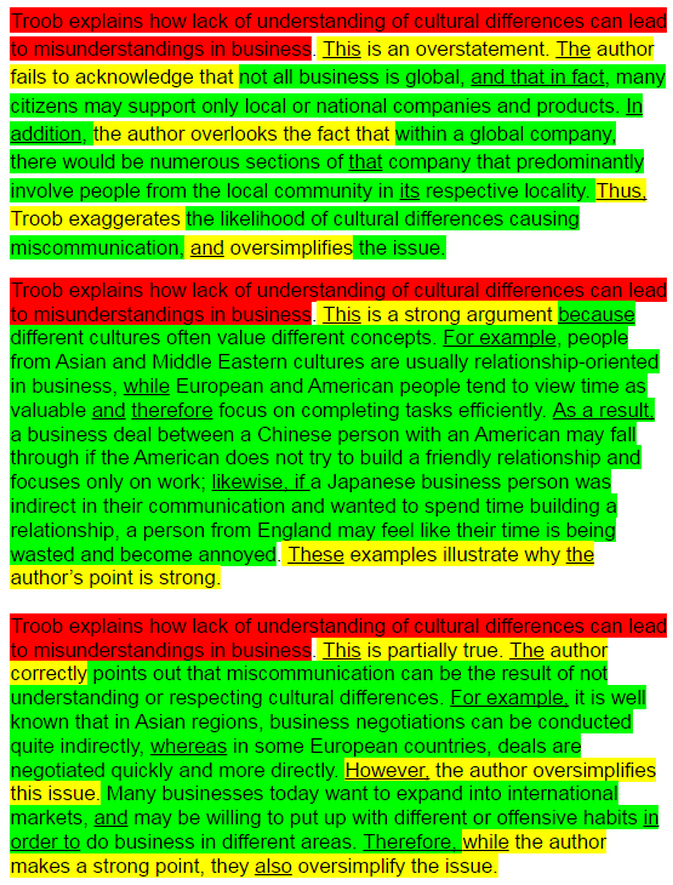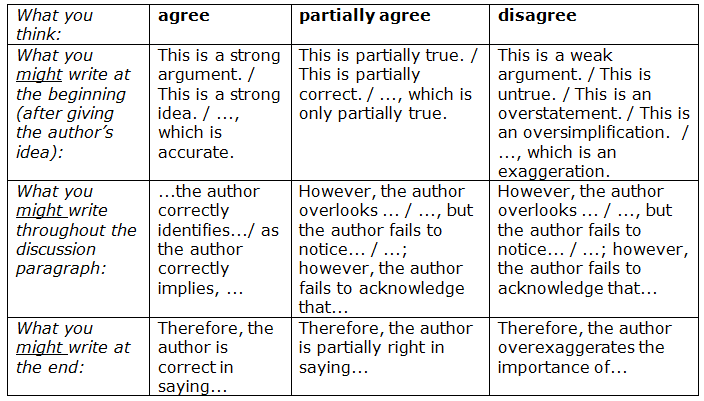That’s fine, but don’t expect to pass exams or university courses!
3. Organise your ideas then start writing.
Do a quick plan from your notes to make sure you:
- include important points
- paraphrase everything
- have a logical order
- can see where main points can be connected
Here's an example of a plan:
Not so clever country?
Plan
- economic benefits
- higher taxes are paid
- communities benefit because more jobs and more active economy
- societal benefits
- ability to think critically
- specialist skills
- less burden on health care system
- less likely to commit crimes
Ideas from article 'Not so clever country?' in RMIT English Worldwide Advanced Passport book
Now you're ready to write! Remember to first put your heading: Summary.
Your first sentence should include:
- the author’s full name (or authors' names if you have two or more)
- the title of the article/s
- the year of the article/s
- the overall topic of the article/s (or their overall position/s)
Then, connect all of the main points together using:
- your own words (avoid copying anything from the original article)
- cohesive devices
- linking words e.g. First / The author adds that / Thirdly, / Her last point is ... *use the author's family name after the first sentence
- referents e.g. this / it / the / which
- a range of reporting verbs (e.g. claims / states / believes / argues / points out / thinks)
- different sentence structures (simple, compound, complex – if you don’t know how to do this, watch this video)
- academic vocabulary including appropriate collocations
Let's look at an example of a single summary. Note the reporting verbs (in yellow) are in present tense. Even if some of your main points have different verb tenses, you should always keep reporting verbs in present simple.
Not so clever country?
Summary
In the article 'Not so clever country?', Marion Jacobs (2010) argues that cuts to funding for universities have a negative impact. She believes that universities should be supported because of the economic and societal benefits they provide. The economic advantages she explains include more taxes from graduates and extra jobs and income for local communities. Lastly, Jacobs claims that benefits for society include not only graduates' ability to think critically and their specialist skills, but also that they are less of a burden on the health care system and are less likely to commit crimes.
(95 words)
What if I need to talk about two articles?
Then you can either summarise them separately or together – use the one you prefer or the most suitable according to the number of main points in the articles. If you put the summaries together, you will have contrasting language between the different articles’ main ideas e.g. while / whereas / but / however. If you do two separate summaries, you will only need one contrast linking word in the first sentence of second article’s summary.
You can see all these concepts highlighted below in the example of two summaries:
Two summaries together
In the articles ‘How much English is enough’ (2011) by Jane Cuthbert and ‘Globish? It just doesn’t make sense’ (2014) by Peter Jackson, Globish, a simplified version of English, is discussed. While Cuthbert argues that Globish is a useful development in English language teaching, Jackson thinks that it is idealistic and will not work in reality. He believes that the lack of grammar in Globish can cause misunderstandings, whereas Cuthbert states that Globish does not focus on accuracy and is therefore easier to teach or study independently. In addition, she claims that being independent of culture and limited in vocabulary size are benefits of Globish; however, Jackson feels that it is impossible for language to be separated from culture, as well as the fact that Globish’s limited vocabulary may not be enough for business or deeper levels of communication.
(139 words)
Two separate summaries
In the article ‘How much English is enough?’, Jane Cuthbert (2011) discusses the advantages of Globish, while in the article ‘Globish – it just doesn’t make sense” (2014), Peter Jackson considers its limitations. Cuthbert (2011) argues that the reduction in vocabulary size and grammar promotes confidence and that 1500 words is sufficient for communicative purposes. In addition, she believes that there is no culture in Globish, which makes it more accessible for students. Finally, the author states that Globish is not only easier to teach than English, but also more useful in terms of developing learner independence.
However, Jackson (2014) argues against Globish. He believes that its simplicity does not mean it is easier to use, because it could lead to communication problems and is not suitable for certain contexts. The writer also argues that the vocabulary range is too small and that culture cannot be separated from language.
(148 words)
Summary - two ways (based on material in the RMIT English Worldwide Advanced Passport book)
What do the colours highlight?
- blue: author's name or referents
- green: linking phrases expressing contrast
- yellow: other linking phrases
It’s important that these are all varied. Why? Because this shows that you can:
- control a range of grammatical structures
- create cohesion (i.e. your sentences flow – like a river!)
- use a range of academic and less common vocabulary (including collocations) accurately and appropriately
- follow academic convention (do things how they want you to at uni)
Note: style variations are possible. For example, if you do summaries separately, you may still like to introduce both authors and articles in the first sentence (like if you put them together) and then do them separately after the first sentence.
What about the discussion section?
I’m glad you asked! This is where you put your own ideas in response to the author’s ideas. Depending on your task requirements, you may need two, three, or even four discussion paragraphs in this section. Each one will show your response and support for your response to an idea from the original article.
What is support?
It’s any extra information that makes your ideas more clear. For example, you might use a reason or two, an example or two, a fact or statistic, or an explanation of a situation to make your response more credible (logical and believable). In reality, you’ll probably mix a few of these together. In the end, what matters is that someone should be able to read what you’ve written and then clearly understand why you’re supporting or criticising what the author has said.






